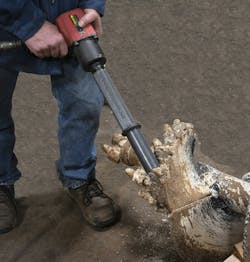How to Speed Auger Bit Changes on Drill Rigs
Scherzinger Drilling is an all-purpose drilling contractor in Cincinnati.
With an assortment of drilling rigs from the U.S., Germany, and Italy, and augers from 18-inches to 40-inches in diameter, their projects run the gamut.
Any given day might see their crews drilling large foundations, retention walls, utilities, and more. Regardless of the project at hand, or the size of the auger involved, they need those augers fitted with new bits for maximum productivity.
An auger bit replacement tool from Auger Technologies is speeding the replacement of worn auger bits, to keep Scherzinger’s augers churning, and both the boss and their customers happy.
Article provided by Auger Technologies, Harrison, Ohio.
Stephen Scherzinger, president of the Cincinnati-based drilling company, knows that no matter what kind of job his crews are on, efficiency is the name of the game. Time is money has never been truer than in the contract drilling business.
A slow, inefficient process
Broken, chipped, or worn auger bits slow down the process. Replacing those auger bits with new ones used to be like, well, pulling teeth. His maintenance team would either pry them out with a fork wrench, hammer them out from behind, or a combination of both if the bits were really stuck.
Sometimes they’d heat them up as well. This was a loud, slow, and potentially dangerous process. And when you go through 4,000 auger bits a year, it was not terribly efficient.
About two years ago, Scherzinger was approached by Auger Technologies which was developing a prototype of their tooth puller, a device designed to quickly and safely remove conical auger bits. After a year of refining the product, Auger Technologies released their Bullet Tooth Puller. Scherzinger bought one for his shop and has been pulling teeth in a fraction of the time and with far less noise than their previous approach.
How the tooth puller works
A split-ring collet slides over the worn bit, then Scherzinger slides the Bullet Tooth Puller driver arm over the collet, locking it in place. An extractor screw, powered with an impact wrench, then pulls the tooth from its blind hole.
Once out, the maintenance crews reverse the extractor screw motion to remove the tooth from the collet. With a more stubborn or rusted bit, technicians combine the Bullet Tooth Puller with some old-fashioned muscle, hammering from behind to loosen the tooth, while simultaneously pulling it from the front.
Scherzinger uses the Bullet Tooth Puller exclusively on their .990-inch auger bits, and estimates that he “has cut his bit replacement time in half.” When you replace 4,000 of that size every year, that “found time” really adds up. The maintenance technicians appreciate simplicity of the new approach as well, as it saves them from the knuckle-busting that routinely occurs when using a fork wrench.
Scherzinger uses the Bullet Tooth Puller in the shop rather than the field, but added that the compact size would be ideal for field use for other drilling companies and utilities. An added benefit of the Tooth Puller is that it reduces the noise in the shop.
Without the constant hammering the shop is less noisy. Now that the shop is quieter and more productive, Scherzinger finds that he’s not inclined to want to pull out his own teeth, and enjoys more productive endeavors.
